Andrea Macdonald, founder of ideaXme interviews Dr. Samer El Sayary multi-award winning architect and Assistant Professor, Architecture Beirut Arab University.
What Sort of Habitats Are We Going To Design To Survive On Mars And The Moon?
Andrea Macdonald, founder, ideaXme: [00:00:17] It’s just a matter of time before humans inhabit the Moon and Mars. But what sort of habitats are we going to design to survive there? I’m here with somebody who has considered this question, a multi-award-winning architect. In your words, who are you?
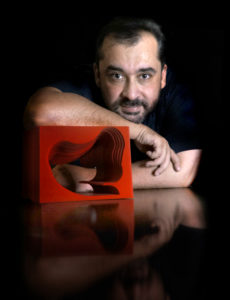
Dr. Samer El Sayary, Assistant Professor in Architecture: [00:00:59] My name is Samer El Sayary. I’m an Assistant Professor of Architecture, At Beirut Arab University. I’m a researcher and an award-winning architect. I have a special passion for outer space architecture. I graduated 20 years ago in 2001, at the top of my class. Through the years have gained over 36 awards and prizes. Most of them are from international institutes, across four different continents. I served as a Mars City Design ambassador for three years in Los Angeles, and that was because I was awarded the first prize in 2017. I’ve also served at The Jacques Rougerie Foundation as a junior ambassador in Paris, which I have been doing for the last two years and I still represent them. This is because I either won or was shortlisted for a prize for six years in space architecture competitions.
Dr. Samer El Sayary’s Work At NASA Johnson Space Center
Dr. Samer El Sayary, Assistant Professor in Architecture: [00:01:55] I’ve succeeded in exhibiting my work in several countries, including NASA’s Johnson Space Centre in Houston in 2019. I’ve exhibited in France twice in 2016 and 2020. In Greece during 2015, in Tunisia during 2011 and in Egypt in 2011 and 2013 during some prestigious awards and honours. My work has been featured in the Discovery Channel UK, on Dutch TV in California Dreamers, Wired Magazine in 2017, Up- Magazine, L’arca magazine, Architectural d’aujordhui, universetoday.com, designboom.com, archdaily.com, spacearchitect.org, among many others.
Dr. Samer El Sayary, Assistant Professor in Architecture: [00:02:33] I see myself belonging to the first generation of space architects who will write the future, turning science fiction into design reality. We see ourselves as the people who will pave the road for humanity to survive and thrive outside of Earth in the near future and on Earth as well, by using existing technologies or near future technologies. We always say that you should expect the unexpected, but we work in the near future. It is already there; we just have to gather all of the threats and start weaving them together to show how our own design fiction will serve humanity.
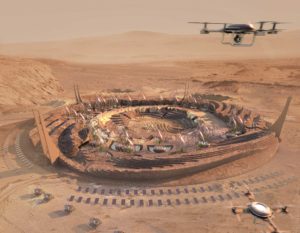
Dr. Samer El Sayary, Assistant Professor in Architecture: [00:03:31] I can define myself as a science-tect. It’s a new expression that means an experimental architect who uses science in making architecture and then experiments with this architecture and finally, produces scientific papers. As a by-product of the awarded projects, just a couple of weeks ago, I succeeded in publishing in the Q1 Scientific Journal, Solar Energy Journal. I work in a closed loop circular way, starting by reading science, producing architecture and then experimenting with this architecture, reaching new conclusions and then writing new scientific papers.
Dr. Samer El Sayary, Assistant Professor in Architecture: [00:04:14] I can also define myself as an entrepreneur. I don’t have a team work to work with, unless it is in science. But in my architecture, I have this vision. I used to travel all over the world to 13 different countries with my laptop where I was experimenting and meeting new people, including scientists, engineers, experts, and learnt from all of them. It is very important for the architect and the scientist to be exposed to different cultures and different scientific backgrounds. I can say that I’ve participated in numerous workshops over the years. I continuously explore the relationship between the qualities of the past and the endeavours of the future. I am from a place where the people used to walk on the same road that I take to the university every day for the last 5000 years. Which represents legacy. It is very important to respect the accumulated science of these people throughout thousands of years.
Dr. Samer El Sayary, Assistant Professor in Architecture: [00:05:20] I do believe that we are living in this era and we have a responsibility to take all of this accumulated science and rethink it, redefine it using cutting edge technology, what we have today and what is available today and to anticipate what will be available in the near future. Then our responsibility is to deliver to the future generations what we have done. We have to leave our print today for the future generations. So, I continuously explore the relationship between the qualities of the past and the endeavours of the future, trying to find a meeting ground.
[00:06:36] In developing designs for habitats in space, as you mentioned, you have to be a futurist. It is very different to the way in which you put together a design habitat for Earth. Could you please explain to the audience the different elements that have to be taken into consideration, for example, in building a habitat for the Moon?Architecture Reflecting A New World System
Dr. Samer El Sayary, Assistant Professor in Architecture: [00:07:12] Of course, first of all, I define my work in architecture, especially in outer space architecture, as having a holistic image about the new world system. It’s not just about designing a habitat on its own. Everything is connected to everything. If I didn’t study the socio-political landscape and the everyday changes in the advancements of technology, I wouldn’t be able to design for moon habitats.
Dr. Samer El Sayary, Assistant Professor in Architecture: [00:07:39] So, about moon habitats. I have designed three projects. One is called Project IRIS, the other is Project Stonehenge or Chimera Project in the South Pole and lastly, the Oasis project in the lava tube in Philolaus crater.. My school of thought is built upon three main points. First of all, it’s digging deep in knowledge and science accumulated through thousands of years to capture hidden values and our history, our legacy and the intangible strengths of it. Then I re-think those values, as I have mentioned earlier, using cutting edge technologies to create architecture that carries the spirit of the past, not in its morphological dimensions, but in its core social and human experience.
Dr. Samer El Sayary’s Lunar Palm Tree
Dr. Samer El Sayary, Assistant Professor in Architecture: [00:08:31] I also document those experiments through awards and scientific research papers. I would like to tell you a little bit about these projects. The Lunar Palm Tree was a project I produced in 2015. Lunar Palm Tree was a tower built in the Sea of Tranquillity. It’s a very vast place in a documented location by the United Nations as a Heritage site.
Dr Samer El Sayary’s Project Oasis
Dr. Samer El Sayary, Assistant Professor in Architecture: [00:08:59] It was the site of the landing of the Apollo missions. So, I thought it would be the best place to have a touristic project. It is a project that I think would be a coalition, an alliance between the Gulf Council countries designed for Luna tourism. Later on in 2018, I built a project called Project Oasis. Project Oasis will be the first lunar settlement, a complete settlement, permanent settlement, which we define in our practice as a third phase colonization. It is a kind of colonization where people will be tend to stay there and not return back. It’s not temporary, it’s permanent. So it was critical for me to transfer part of Mother Earth into this place and try to build artificial or synthetic nature inside it. It is community centre design. It is not only a human cantered design.
Dr. Samer El Sayary, Assistant Professor in Architecture: [00:09:55] I would like to switch the traditional thinking of the space architects that are practicing today from just human centred design perspective and focus on a limited number of individual communities in a complete society. I think that might appear maybe 150 years from now.
Dr. Samer El Sayary, Assistant Professor in Architecture: [00:10:15] Also, one of the most important projects that I thought about, and it received an award in 2020, is Project IRIS. It’s an orbital elevator that takes us from the surface of the moon to the geosynchronous Lagrange point five. It’s an equilibrium point between the Earth’s gravity and the Moon’s gravity. This critical project will be so important because it will be the foundation of what I call the fifth industrial revolution, the ExO economy, the interplanetary economy. It will be the economy that will have the Aqua, I call it Aqua which will be a kind of cryptocurrency between both communities, the Moon and Earth. Project IRIS will act as the railroad that will connect the resources with the factories and vice versa.
Dr Samer El Sayary’s Project Iris
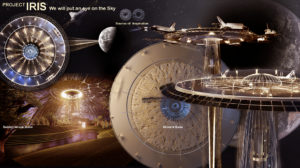
Dr. Samer El Sayary, Assistant Professor in Architecture: [00:11:08] The last project on the Moon is Stonehenge or the Chimera, and this one is a little bit crazy. But I do believe that without craziness, we wouldn’t have found today’s technology. What we have today, like communicating through the Internet, was something like magic hundreds of years ago. It was something that could never be expected or anticipated.
Dr. Samer El Sayary, Assistant Professor in Architecture: [00:11:34] The Moonhenge Project or Moon Stonehenge project, is a kind of architecture that will be carrying and embedding our human DNA inside of it. It will contain our genetic map inside it. It will be a kind of architecture where we leave our print and our story as a time capsule for the future generations and maybe other intelligent life forms that could explore the site and know more about us. We will bring our history inside this architecture, using the parameter design and generative technology. I used to study the behaviour of bone growth and start making structures, mimicking the same process.
Andrea Macdonald, founder, ideaXme: [00:12:23] Can you take us through the different things that you have had to consider looking at how people are going to sustain themselves? How are they going to get water? How are they going to source food? What sort of energy are they going to use?
Resources, Systems and Designs To Support Human Survival in Space
Andrea Macdonald, founder, ideaXme: [00:12:46] To take it back to survival, what are the things that you have addressed in your design, that deal with actually being able to survive on the Moon?
Dr. Samer El Sayary, Assistant Professor in Architecture: [00:13:00] First of all, I’ll talk about energy. By coincidence, I teach the history of architecture and I do believe that the beginnings are always similar. They’re all similar. Millions of years ago when the human settlement started, the two main, most important and critical issues were energy and water. If we have water, we can drink, we can plant, we can have animals. We can have all kinds of flora and fauna that we need to start a settlement and the same goes for the energy.
Rd. Samer El Sayary, Assistant Professor in Architecture: [00:13:35] In 2015, NASA announced that they found frozen water beneath the surface of the moon. That was the sign that we should start writing our design fiction and making our architecture and writing the future.
Dr. Samer El Sayary, Assistant Professor in Architecture: [00:13:50] Regarding energy, I believe in the diversification of energy sources, so I mainly use four kinds of energy power sources. The first one is the solar satellites, and I do believe it is very important to connect the Earth and the Moon with a set of satellites. It will make a data link and will be the data package that links the Earth and the moon in real time enabling the VR control. It will also be important to beam back energy collected from the sun’s rays to different colonies, even inside of a lunar cave. So that would be my first power source.
Dr. Samer El Sayary, Assistant Professor in Architecture: [00:14:30] My second power source will be mobile, small sized nuclear reactors. They are similar to those used in the submarines of today or the icebreakers. After some research, I realized that it is developing rapidly and we can find many of the source of fuels needed to produce nuclear reactors on the surface of the [00:14:54] Moon, for example, Helium 3 [00:14:55]. That will be the second source of energy.
Dr. Samer El Sayary, Assistant Professor in Architecture: [00:15:01] The third source of energy is using what I call, low cost energy generating systems like the piezoelectric floor tiling. Piezoelectric floor tiling is important for my designs. It does two things. It helps people and motivates them to start to exercise and move inside the colony, which is crucial for their survival and for the cardiovascular system and their bone density. They have to practice a sport for around two hours per day. At the same time, during practicing this exercise, they are generating energy. So that will be the third part.
Dr. Samer El Sayary, Assistant Professor in Architecture: [00:15:41] So that’s the solar satellites, the nuclear energy and the piezoelectric floor tiling. What else did you mention in the question?
Andrea Macdonald, founder, ideaXme: [00:16:03] Food and water.
Dr. Samer El Sayary, Assistant Professor in Architecture: [00:16:05] Regarding food and water. One of the most important things developed recently are the four main ponics systems, the hydroponics, the aquaponics, the fogponics and the aeroponics. These four approaches to food production will make up the main food production system. There’s a classic debate between engineers and architects. Engineers believe that the science will be driving the architecture. While we as architects, first think about the humanitarian element and then we believe that the science will serve us. This kind of debate is actually a fruitful argument.
Dr. Samer El Sayary, Assistant Professor in Architecture: [00:16:51] I do believe that the life support system that would be crucial for the existence of the human communities in space will be regenerative. Maybe it will be a closed loop circular kind of food production system, but it is very important to transfer part of our earth and our nature to this space, this will add to the food production system.
Dr. Samer El Sayary, Assistant Professor in Architecture: [00:17:14] The psychological benefit is also very important for our health and maintenance. We have a pattern of psychological problems caused by claustrophobia, for example. A circadian cycle is also important, ensuring that we have 12 hours of light and 12 hours of darkness, and that the light is changing in intensity and colour to maintain our mental health. So, I’m trying to transfer this part of nature and then blend it with existing technologies and engineering solutions that would be regulating and managing everything to maintain our health.
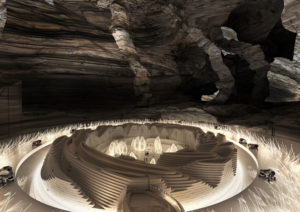
Andrea Macdonald, founder, ideaXme: [00:17:58] Roberto Garcia, who leads the ideaXme research group has a question for you. He’s intrigued to know what you anticipate the impact of neuro-architecture will be on habitats in space versus Earth. Of course, you’ve covered certain elements of that question already. If you could address anything further that would be great.
Dr. Samer El Sayary, Assistant Professor in Architecture: [00:18:35] Neuroscience architecture is a very interesting notion. I do believe in the near future there will be a convergence and merging between biology and architecture. They won’t stay apart. Inserting our DNA into our construction systems and into our structures is one part. I do also believe that it is very important that our buildings in the future will feel and have emotions toward us.
Dr. Samer El Sayary, Assistant Professor in Architecture: [00:19:06] There’s two important quotes in architecture. One of these quotes calls the house a machine to live in. The other quote says that the house should be a living organism that lives with you. I believe in having both of them. Why not merge the machine and the living organism and have something like artificial neurons, something like synthetic neural connections and sensors inside the buildings.
Dr. Samer El Sayary, Assistant Professor in Architecture: [00:19:37] Today we can just open an iPhone and talk to Siri. So I think in the near future, artificial intelligence will be developed to have some kind of emotions and to start to anticipate our emotions, our aspirations and our dreams. Maybe one day my house could anticipate that I’ll be sad, so it’ll start to cheer me up and start creating a different mood, maybe by changing the colours of the paint. I do believe this will also be made possible using digital technologies and things like a smart kind of glass.
Dr. Samer El Sayary, Assistant Professor in Architecture: [00:20:12] I have been working with this concept since 2006. I believe that the future of architecture, either on the Moon, which will be a very important, critical inclusion, or on Earth, should be a self-repairing kind of architecture. We already have some papers that have been dealing with these kinds of smart materials that have the capability and the ability to self-repair. Just like any one of us, if we have an injury or cut ourselves, after a couple of days we start healing. I think the architecture should also be able to heal itself which will guarantee its renovation for hundreds of years. There is science that can interpret that vision, but I have much more of a further vision for scientists to work on.
Dr. Samer El Sayary, Assistant Professor in Architecture: [00:21:03] 200 years ago, Jules Verne expected that someday we will be put in very huge metal vehicles and we will go to the deep sea and around 160 years later, we invented the submarine. He thought about having a cannon and putting humans in this cannon and shooting them to the Moon, and in 1969 at the start of the Apollo 11, we landed on the Moon. What we are talking about today with the very advanced pace of technology, will be tomorrow’s reality.
Who Owns Space?
Andrea Macdonald, founder, ideaXme: [00:21:40] There’s a space race going on between Elon Musk, who’s the founder of SpaceX, and Jeff Bezos, founder of Amazon and Blue Origin. There’s also this background battle going on that really is not so much in the public domain and that relates to who owns the Moon, who owns Mars. Who do you anticipate your client will be if you get a contract to actually develop one of your habitats on the Moon or Mars?
Dr. Samer El Sayary, Assistant Professor in Architecture: [00:22:16] That is a very smart question. I do believe that it is very important to have a healthy competition. They are pushing the boundaries of our technology. To let people know about my client, let me tackle my future project. I am one of the people who is thinking about founding or inventing something new, merging social media technology and 3D printing technology. I do believe in the future I will be opening my own practice, my own foundation, that will sell and share and buy 3D models, the kind of models that could be printed to any foundation or hospital or factory.
Dr. Samer El Sayary, Assistant Professor in Architecture: [00:23:12] We’d be able to send and ship to the Moon or to Mars a 3D virtual heart custom made for a patient in Los Angeles, for example. To be 3D printed maybe on a molecular level in the medicine space vector will be founded someday in the near future, and then they will be sent back to our patients. I believe that in the future you won’t be able to transfer your industry and it’ll be much cheaper and more convenient to send models and to receive 3D scan models from the foundations. The research labs and scientific labs that will be founded on the Moon and Mars and their findings will be used to serve us on Earth.
Dr. Samer El Sayary, Assistant Professor in Architecture: [00:23:58] There’s a merge that will occur between the virtual technology, the 3D printing, the 3D scanning and the cryptocurrency. Ideally, cryptocurrency would thrive in the future, and I called it the Aqua because it will be connected to the reserves of water. The water will be the most important commodity in the future of space colonization and space missions. It is also very important to have some kind of currency that could be transferred easily.
Dr. Samer El Sayary, Assistant Professor in Architecture: [00:24:27] This is the future that I expect will exist in a few years, maybe 20 or 30 years maximum. Almost everything that I have said, I think will be happen. I think my client will be a client on Earth or the Moon or Mars. I don’t have any boundaries about it, but the important thing is to find something to serve humanity, to find something new, to forge an original footprint to serve the course of mankind.
Andrea Macdonald, founder, ideaXme: [00:25:18] There are certain parts of society which are trying to stop any commercial ownership of planets and land on those planets. The argument is that they should be regarded as mankind’s land rather than belonging to a private individual. There have been moves recently in America such as discussions whereby it might be possible for a private individual to own land on Mars or on the Moon or both. It would be really interesting to hear your opinion on that. Should anyone own the land on those planets, and if so, who do you anticipate, if you’re building a habitat there, your client will be?
Dr. Samer El Sayary, Assistant Professor in Architecture: [00:26:20] First of all, let’s discuss a little bit about the treaty. The treaty was founded in 1967 stating that no nation should have the right to own any celestial body or part of the celestial body. It is a very interesting treaty that served the technology and the nations of that time.
Dr. Samer El Sayary, Assistant Professor in Architecture: [00:26:39] With today’s technology, with today’s ambition and aspiration, we have to rethink this treaty. My expectations are that the private sector will take over the whole space industry or most of the space industry. They have the resources, they have the money and maybe in the future they might even have their own military, I don’t really know. I don’t want to discuss a dystopian future or a utopian one either. I do expect that the private space sector, which started 10 years ago, will have less obstacles, less constraints, and all the resources, even the science. They produce their own science.
Dr. Samer El Sayary, Assistant Professor in Architecture: [00:27:25] The private sector has won the race with NASA. Today NASA has started to use the private sector. I don’t believe that someone should own a part of the Moon or Mars. The resources, regarding what you find, you can take, is another part of the treaty. Moon mining or Mars mining will be open to all nations and it will be open to the private sector. I think that this will be the future, not owning the land, but owning the resources.
dearMoon
Andrea Macdonald, founder, ideaXme: [00:28:04] You have a plan to go up into space and have a look. You’ve applied to dearMOON. Can you talk to us about the dearMOON project and the application process as well as your hopes for being one of the eight artists to fly in Elon Musk’s rocket in 2023?
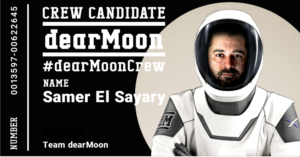
Dr. Samer El Sayary, Assistant Professor in Architecture: [00:28:31] Yeah, this was a very interesting process that I was really surprised by. After classes that I teach at university, I used to stay and look to the sky and tell my students, this is where I will be building my projects. I’d just point to the Moon and say, this is where I live most of the time, even if it is virtually. As an architect, before I start designing, I should be visiting the site. Of course, the moon is a very, very hard site to visit.
Dr. Samer El Sayary, Assistant Professor in Architecture: [00:29:08] I have visited the Moon virtually. I have constructed every kind of site in the Shackleton Crater. I have contoured it and constructed it in 3D, walked through it using VR technology, through the Sea of Tranquillity and most of the lava tubes discovered up until now.
Dr. Samer El Sayary, Assistant Professor in Architecture: [00:29:26] I am so far off from being an astronaut. Astronaut qualifications are very hard, but by having this opportunity, I think it will open the door. Even if I am not selected, it will be a good step and it is important. I have a responsibility to apply to this competition. By the way, dearMOON is open to the public, anyone can apply for it. The important question, do they have the courage to continue in the application if they are selected?
Andrea Macdonald, founder, ideaXme: [00:30:06] Can you talk to us about the application process or what sort of information you had to supply?
Dr. Samer El Sayary, Assistant Professor in Architecture: [00:30:13] It’s a multi-stage process. First of all, you have to introduce yourself to the organizers of the competition. You have to put your name, phone and address and everything. Then there is an initial screening process and they really didn’t reveal much about it. From my knowledge about astronaut selections, they need to be sure that you have the guts and the courage to proceed and that you have the qualifications.
Dr. Samer El Sayary, Assistant Professor in Architecture: [00:30:49] I believe that the selected candidate should have two main elements, enough knowledge about STEM, maybe a master’s degree or a Ph.D. and high physical fitness. These are the two most important, crucial parts before having the essential training for the Moon mission. The Moon mission is not like any ordinary mission. I think that all of the eight individuals that are selected will also be acting as members in the organization, the running and the process of the mission itself, not just as a tourist or as a guest.
Dr. Samer El Sayary, Assistant Professor in Architecture: [00:31:32] So, the initial screening will be made and after the initial screening, there would be an interview. The last thing will be the medical check-ups, up to what I’ve read on their website. I would really like to proceed in this mission and I’m willing to do whatever it takes to do so.
Andrea Macdonald, founder, ideaXme: [00:31:50] In the application so far did you have to upload any of your work? Did you have to write a summary of why you want to go there, what you would get out of the experience, or is it just registering?
Dr. Samer El Sayary, Assistant Professor in Architecture: [00:32:08] The first thing is to register. In the initial screening, I have to do all of what you mentioned. They have to know more about me and my background and everything. You know, architecture is the crossroads of science and art and that is what I believe I have.
Andrea Macdonald, founder, ideaXme: [00:32:26] The competition is run by a Japanese billionaire who has an incredible art collection. He wants the impressions that artists bring back from that experience to impact the whole of mankind through the work that the artists create. Is that true?
Dr. Samer El Sayary, Assistant Professor in Architecture: [00:32:50] Yes, that is true. Actually, art hasn’t had a good opportunity in the race of science. Since 1969, the first Apollo mission, it was only about science, but I think art is also important. If you just study the history, you’ll find art was very important in documenting all of the heritage, including most of the heritage done by the Europeans in the Middle Ages and the early modern age. Some people find that art is a frivolous topic, no, art is important.
Dr. Samer El Sayary, Assistant Professor in Architecture: [00:33:27] For example, in this pandemic and lockdown that we have experienced, without art, we couldn’t survive. Without watching a movie or listening to music or even painting, we wouldn’t stand the long periods of the lockdown. I think art will also shed light on an important part of human spirituality, human aspiration, human ambition. It is half of the story, the science is the other half.
Dr. Samer El Sayary, Assistant Professor in Architecture: [00:34:01] The scientist can define the scientific facts by writing equations, but the artist has feelings and emotions toward new facts, especially if it is an abstract fact like what’s on the Moon. It is very important and I believe it is important in our realization and conception of outer space.
Andrea Macdonald, founder, ideaXme: [00:34:26] There are a number of astronauts-artists, most famous of which is Nicole Stott. She’s now a veteran NASA astronaut and a space artist and involved in many initiatives to improve life on this planet. She’s a big proponent of connectedness, for us all to realize how connected we are.
Andrea Macdonald, founder, ideaXme: [00:34:58] One of the things that she speaks about regarding her experience from space is a term called the Overview Effect. Looking down at the planet, there is this realisation that war, that competition, that fighting and conflicts and not working together, not collaborating is such a waste of time because we are all one. I was just wondering what your opinion is of the Overview Effect. Some people see it as a religious experience.

Dr. Samer El Sayary, Assistant Professor in Architecture: [00:35:39] I know a lot about the Overview Effect.
Dr. Samer El Sayary, Assistant Professor in Architecture: [00:36:24] Sometimes we have to go out of the planet to see how small we are. We really don’t need to fight. Our cultural differences should enrich us, not cause misery to our future generations. This is important. In most of my projects I address this issue exactly, how can we fuse or how can we melt our cultural differences and use this cultural diversity to enrich us. As well as using geometry and some spaces that make people think as one nation and one destiny with one common future. This is the most important part.
Dr. Samer El Sayary, Assistant Professor in Architecture: [00:37:03] I believe in the Overview Effect, but, for me as a space specialist and working with space architecture, I have experienced this Overview Effect years ago during my virtual immersion in space and the Moon. I know how small we are. It’s human nature to have conflicts, it’s been human since the first human being stepped on Earth until now, we can’t really fight our nature.
Dr. Samer El Sayary, Assistant Professor in Architecture: [00:37:35] Some people with dystopian views think that after the Mars nation rises to the third or the fourth phase of colonization when they are a major power and have declared independence, military conflicts might occur between planets. So it’s human nature but it takes wise thinking to rethink our conflict, to think that we all have the same eyes, the same anatomy, the same body, the same spirit and the same feelings. We will find that convenient when we discover the first intelligent alien life form by feeling this threat that there’s another intelligent life form that might advance us. At this point, I think we might unite.
Andrea Macdonald, founder, ideaXme: [00:38:20] I’d like to explore connection with you a little bit further. We all sit in this information age where people are encouraged to connect with huge numbers of other people across the planet from different walks of life. To a certain extent, that’s a positive thing, but it’s actually the rich connections that move our lives and our innovations forward, the people who see something special in us, who help us and they expect nothing back. Most innovators that we speak to have had one or more of these experiences in their life. I was just wondering if that was the case for you.
Dr. Samer El Sayary, Assistant Professor in Architecture: [00:39:10] Well, yes, it is. History has consistent patterns of people. The natural cycle of innovator is just to start exploring and start observing what is around. Once you know the patterns and start normalizing the pattern, he starts to make his small additions. Step by step, he is turning a routine everyday design into an innovative design which turns into a creative design which is on a little bit higher level and he then has the original design. After achieving his first prototype, he runs to the second and the third and starts building a complete legacy.
Dr. Samer El Sayary, Assistant Professor in Architecture: [00:39:48] At some point he should stop and start looking at the people and the society around him. He needs another innovator. No innovator can work alone. Bill Gates, for example, after some accomplishments and the added value that he has provided us, he started making his own foundation. Most of the charity foundations are also about innovation, making the first toilet in Africa, for example, addressing one of the poorest nations on Earth and trying to serve humanity.
Dr. Samer El Sayary, Assistant Professor in Architecture: [00:40:24] I do believe in the B.I.G – books, individuals and goals. I’m inspired by many people like Einstein, who’s one of my role models and Elon Musk, one of my modern role models, Tesla and Edison, there are a lot of innovators in this world. Some of them have passed away, but some of them are still will us today. I didn’t have the privilege of one of these people being my mentor or tutor so I read the books and started reading about these great people and I found a common pattern between all of these innovators. That was the first lesson that I had to learn, to know what the common pattern is and then what are the mistakes that these guys had made.
Dr. Samer El Sayary, Assistant Professor in Architecture: [00:41:19] I found that it’s important to live with these guys through books, through documentaries and through even imagining them tutoring me and mentoring me. After a couple of years, I started having my own identity, my own innovation. After learning and getting familiar with the pattern, I started to leave my footprint and started making my own added value. Let me tell you something, I still have a lot of time and I need many years to complete what I have started today. The really good thing is that I’m accumulating all of my accomplishments, I’m not working for an award or just a prize. No, I am testing my vision through awards and prizes, so it’s the other way around.
Dr. Samer El Sayary, Assistant Professor in Architecture: [00:42:05] I have this big vision, as I’ve told you before, about the new world system and have started deconstructing this image into separate projects. In each competition and award, I start by submitting one of these projects just to get the feedback, and by coincidence, most of them or all of them I win.
Andrea Macdonald, founder, ideaXme: [00:42:28] On a more personal level, has anyone reached out to you maybe at the beginning of your career when you had some uncertainty, saw something special in you and helped you to move forward? I’m interested to hear that. That, in a sense, is what I mean by rich connectedness. It is this generous act which expects nothing in return, and then that very often leads to huge innovation.
Andrea Macdonald, founder, ideaXme: [00:43:05] It starts with the spark, a selfless spark where somebody takes time in their day or in their life to help someone else that they see something special in, Then much later down the line that person they helped creates something that impacts our world.
Dr. Samer El Sayary, Assistant Professor in Architecture: [00:43:24] I do remember my professors at university. I didn’t understand the kind of traditional education where you go to class and some professor or tutor just provides you with the essential knowledge and maybe some training in new kind of skills. On the contrary, some of my professors have inserted something that is much more important inside of me. Which is to never get satisfied with what we have done because there’s always something better. That was a very important lesson.
Dr. Samer El Sayary, Assistant Professor in Architecture: [00:44:04] These professors, unfortunately, have passed away years ago, but they have left their legacy inside me. This was the start. Having a particular person, I think it would be putting a limitation on my dreams, but having something good from each individual that I meet, even from my students, is important. I write down every kind of advice that I get. I never take it lightly. I appreciate and value each piece advice I get and start exploring it. My students might have the innovation, but not enough experience. So, when they advise me and give me an idea or a concept, I do thank them. I give them the credit and start developing the idea and maybe work with them in a team on a research paper. It’s like carrying a bag, the journey is so long and you start picking a flower from each garden that you pass on your journey.
Andrea Macdonald, founder, ideaXme: [00:45:01] If you could meet anybody in the world, who would it be? It could be somebody to move your career even further forward or not connected to your career at all?
Dr. Samer El Sayary, Assistant Professor in Architecture: [00:45:14] My answer to this question might sound a little bit crazy, but always remember that the crazy people are the only people who are capable of changing our lives. Who I would die to meet is the future version of myself. What am I going to look like? What am I going to contribute to my career in maybe 20 years’ time? I would like to meet the people who would be reading about me in the history books, what have I done?
Dr. Samer El Sayary, Assistant Professor in Architecture: [00:45:48] This vision started when I was a teenager when I was 16. That was because of the time traveling movies and I got inspired and started thinking, can I meet my future version? Later on when I got a little bit older, I started thinking it shouldn’t be a dream, it should be an inspiration. What should I expect out of myself in the future? What is the image that I would like to build for mankind? What is the kind of contribution that I would like to give?
Dr. Samer El Sayary, Assistant Professor in Architecture: [00:46:23] As the years have gone and I have got older and older, I start turning this image into plans and start working on these plans and developing them. I never get satisfied with what I’ve done, even if it was the first prize in an international competition. I know inside of me that it is not enough, it is not sufficient. For sure there’s something better that could be brought out of it, and this is the future version of me. This is the only person that I would like to interview.
Andrea Macdonald, founder, ideaXme: [00:46:52] Dr Samer El Sayary, [00:46:55] “Shukran Li’l Muhaddatha il yawm” thank [00:46:58] you very much for the conversation today. It’s been an absolute pleasure.
Dr. Samer El Sayary, Assistant Professor in Architecture: [00:47:03] I would like to extend my thanks to you and to ideaXme. Let me finish the interview with a quote that I’d like to tell the audience.
Dr. Samer El Sayary, Assistant Professor in Architecture: [00:47:16] I can see that the future always belongs to the people who can believe in the power of their ideas and the beauty of their dreams. Our technology is the dreams of the people from the past and I do believe that someone with a dream can never be fazed.
Dr. Samer El Sayary, Assistant Professor in Architecture: [00:47:38] Thank you so much.
Contact Dr Samer El Sayary:
Credits: Andrea Macdonald, founder ideaXme.
If you enjoyed this interview, please check out ideaXme interview with Amy Karle, BioArtist and Futurist.

Find ideaXme across the internet including on iTunes, SoundCloud, Radio Public, TuneIn Radio, I Heart Radio, YouTube, Vimeo, Google Podcasts, Spotify and more.
ideaXme is a global podcast, creator series and mentor programme. Our mission: Move the human story forward!™ ideaXme Ltd. Our passion: Rich Connectedness™!

Pingback: News From SpaceTREx: The Lunar Ark - ideaXme
Pingback: Building the NASA Mars Ingenuity Helicopter - ideaXme